ORDINARY BEAUTY, MODEST MIRACLES:
Max’s Travel Journal, summer ’08
St. Louis, then to New Orleans via Amtrak, then on to LA.
CHAPTER TWO: the Spirit of St. Louis
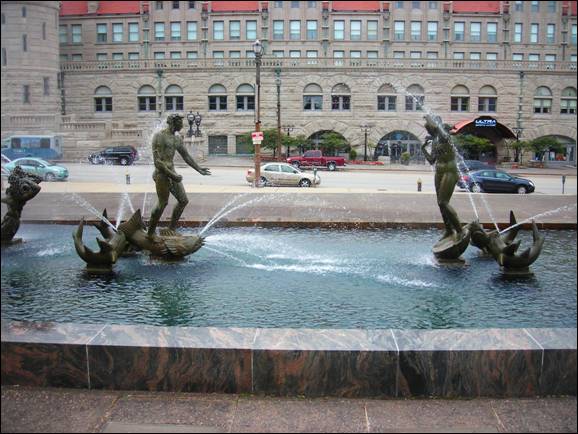
Detail, “The Wedding of the Waters” by Carl Milles, in front of historic Union Station
ST. LOUIS, DAY TWO
A Certain Realm of Heaven
One form of Heaven is returning to a place you know, where you no longer have entanglements, conflicts, or responsibilities. St. Louis is that kind of place for me. Returning here during periods when I’m enjoying a relatively stable life elsewhere, I re-discover the city as a purely aesthetic universe, almost as a world of Platonic forms. Old “personal” hassles and entanglements are mere distant echoes of what they once were. Such echoes ometimes even enhance the richness of my experience. The entire city appears to have been constructed for my benefit. Places I usually treasure only in insubstantial memory are embodied here as solid matter once again.
Furthermore, there is something inherently universal about any city: a hub of activity necessitating specialization of function, vast infrastructures, and complex forms of human interaction for the production and exchange of goods and services and the meeting of needs. The St. Louis metropolitan area is home to around two and a half million people. That may not be on par with Chicago, New York, or Shanghai, but it is nevertheless a mighty energy center that rises here on the plains beside the river. The St. Louis skyline appears suddenly, as dramatic as a mountain range, when you are driving west on I-64 in Illinois.
This area has just about everything—well, it doesn't have an ocean or really high mountains. But the Mississippi and the Missouri are here, and there are lovely hills, which are really old, old mountains, a little to the southwest, whose curves and crags pleasingly kiss the sky. There are some of the world's first skyscrapers, as well as many contemporary, glass-and-steel jobs. There’s a mighty Cathedral—which in fact houses more mosaic art than any other building in the world! There are ancient, grimy factories, with ancient, grimy people still working in them: I learned that when I worked here as a delivery courier, in the late ‘90s. There’s a huge oil refinery at Wood River, Illinois, just across the Mississippi, and old, old steel mills, mostly idle now, in nearby Granite City. There are constant streams of trains and barges, and a pretty good freeway network. St. Louis is still “the big city” for large parts of Missouri, Illinois, Arkansas, and Kentucky.
During my courier days here, as well as a taxi-driving period many years before that, I sometimes felt like an electron moving along a grid, with the central city as the nucleus. Occasionally, however, something would come over me and I'd feel myself as everything—the entire grid, the entire, mystical mandala all at once! It is this ineffable feeling that I still get sometimes on drives through the area when I visit today. That is what I’m struggling to articulate in this montage of poetry, prose, and photos.
For many, St. Louis may be “a nondescript, mid-sized Midwestern city”, but it remains a locus, repository, and continuum of two and a half centuries of human dreams and aspirations, and a much longer span if you include the Mississippian civilization of nearby Cahokia. The concrete forms this ongoing flow of living has created are striking!
A resident of any place inevitably loses some of the sense of an area's extraordinary quality to the "reductionism" of daily life. I’m not saying St. Louis is greater or less than any place else. I’m saying there is a miracle that strikes through the heart of every square inch and every instant of time and space, and it manifests here, as it does elsewhere, in unique ways. I want to show now how that miracle manifests in a random drive through the city, rather than a pilgrimage to its more celebrated “special places”.
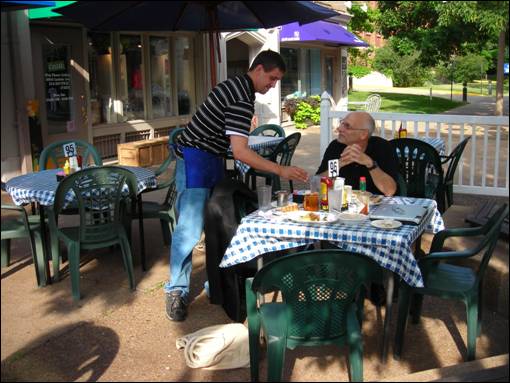
Paul Wagman, one of my dearest, oldest friends, at the Majestic Café in the Central West End
of St. Louis. It's one of the “timeless venues” where we've met during my visits over the years.
Photo Album: a Drive Through the South Side
This section is a treasury of images and thoughts from a ride I took after breakfast on my last morning in St. Louis. I let the steering wheel of my rented Kia turn whichever way it wanted. Whenever my eyes got full of a sight and my fingers started itching, I stopped to take a picture.
Remember, these are not the Arch, the Basilica, or the Mississippi River. This is an old, unsung part of town. I don’t know if the joy, the wonder, the stunning nature of the “ordinary beauty” I found along the way, will come through, or not. Let’s see!
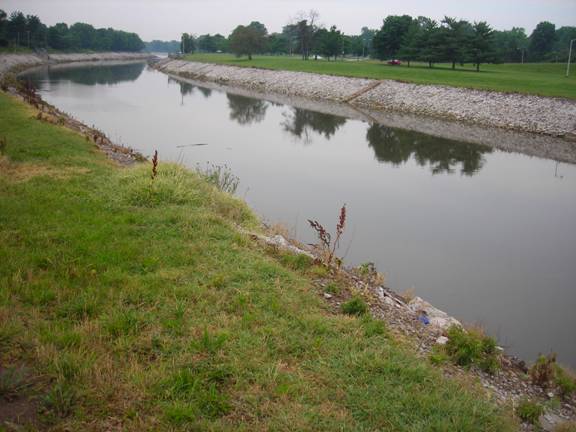
Above, the River Des Peres, south St. Louis: This drainage canal runs for miles through the area, and empties into the Mississippi on the South Side. Way out in University City, it passes where my grandpa lived when I was growing up. A thin strand of woods hid it from his house. We used to climb down and walk along the bed when it was relatively dry. Once I caught a big leopard frog there. Another time we came out with a big leech, which we kept for months as a "pet", in a jar! Youngsters knew the canal, and I suspect still do, as the “River de Pee”. On this cool, cloudy morning in south St. Louis, it was strikingly lovely.
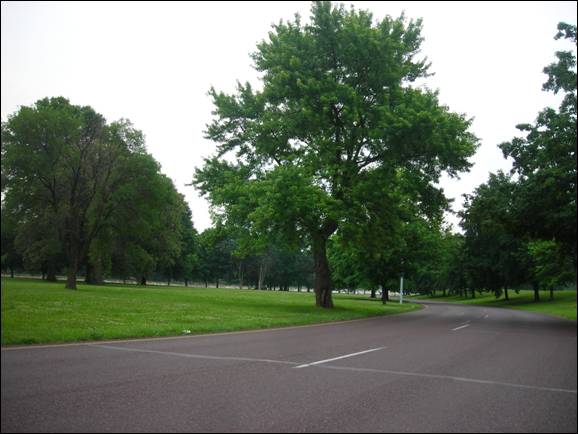
Green Sward: River Des Peres runs through a chain of parks that make this part of the city's south side refreshing to drive through! Trees and meadows go on and on. I don’t know how many people are aware how unostentatiously green the near South Side is.
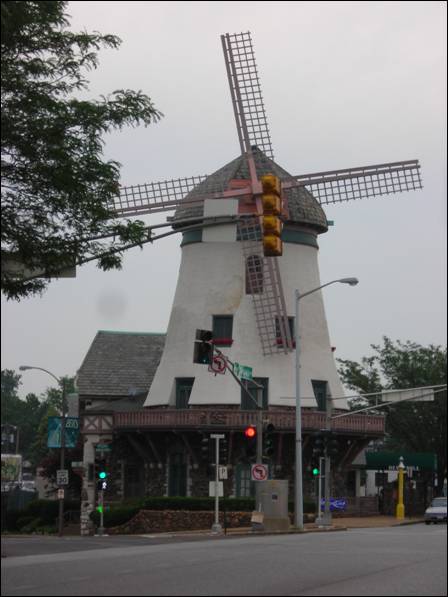
Bevo Mill, Gravois at Morganford: August A. Busch, owner of the Budweiser, the “first in booze” part of St. Louis’ old motto, “First in shoes, first in booze, and last in the American League", built this authentic European windmill in 1915. At first, it was a way-station halfway between Grant’s Farm, where he lived, and the downtown brewery. The Mill has also been a German restaurant since almost the beginning. Inside, it is festooned with the requisite mounted deer heads, glass cases with old beer mugs, etc. Last time I was there, it had a bit of a musty air, but the food was excellent. Aren’t the windmill’s lines lovely?
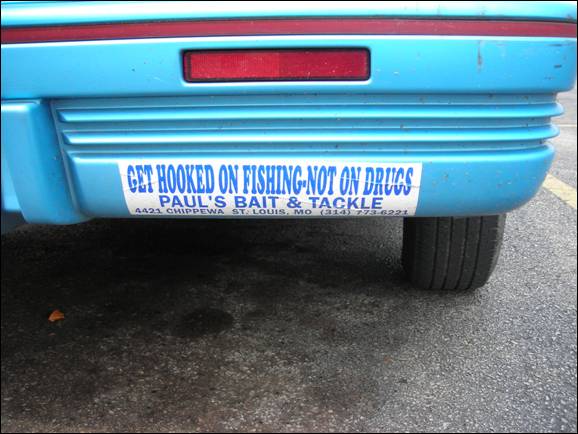
Some Comic Relief: I’ve seen this bumper sticker before. It’s something I never did understand. Or am I wrong? Do we need to alert Washington about this new weapon in the War on Drugs?
CHAPTER TWO (and PHOTO ALBUM) CONTINUED
back to Chapter One
back to Contents
back to Title





